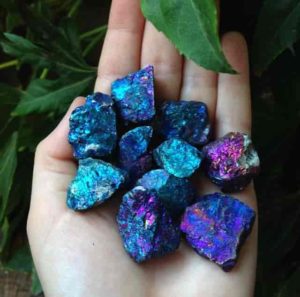
Peacock rock
Chemical Formula: Cu5FeS4
Composition: Copper iron sulfide
Color: Copper-red to yellowish brown on fresh surfaces. Quickly tarnishes to a multicolored purple, blue, and red.
Streak: Dark gray to black
Hardness: 3 – 3.5
Crystal System: Orthorhombic
Rock Type: Igneous, Metamorphic
What is Peacock rock?
Bornite is a sulfide mineral with a chemical composition Cu5FeS4 that crystallizes in the orthorhombic (pseudo-cubic) scheme, also recognized as peacock ore.
On fresh surfaces, bornite has a brown to copper-red color that tarnishes in places in different iridescent shades of blue to purple. Its striking iridescence gives it the peacock copper or peacock ore nickname.
Bornite is an significant mineral copper ore and happens commonly together with the more prevalent chalcopyrite in porphyry copper deposits. In the supergene enrichment area of copper deposits, chalcopyrite and bornite are both typically substituted by chalcocite and covellite. In mafic igneous rocks, in contact metamorphic skarn beds, in pegmatites and sedimentary cupriferous shales, bornite is also discovered as spread. For its carbon content of about 63 percent by volume, it is essential as an element.
What is Peacock rock Structure?
The structure is isometric at temperatures above 228 ° C (442 ° F) with a unit cell around 5.50 Å on the bottom. This design is focused on cubic closed sulfur atoms, with randomly dispersed copper and iron atoms in six of the eight tetrahedral locations situated in the cube’s octants. The Fe and Cu are ordered with cooling, so that 5.5 Å subcells where all eight tetrahedral locations are formed alternate with subcells where only four of the tetrahedral locations are fulfilled; symmetry is decreased to orthorhombic.
What is Peacock rock Composition?
Significant change is feasible in the comparative quantities of copper and iron and solid solution spreads to chalcopyrite (CuFeS2) and digenite (Cu9S5). Blebs and lamellae are commonly removed from chalcopyrite, digenite, and chalcocite.
Where is peacock rock found?
It occurs globally in copper ores with significant crystal locations in Butte, Montana, and U.S. Bristol, Connecticut. It is also gathered in Cornwall, England from the Carn Brea mine, Illogan, and elsewhere. Large crystals can be discovered in the Frossnitz Alps, East Tyrol, Austria; Mangula mine, Lomagundi district, Zimbabwe; N’ouva mine, Talate, Morocco, Tasmania’s West Coast and Dzhezkazgan, Kazakhstan. Traces of it are also discovered among the hematite in Western Australia’s Pilbara area.










